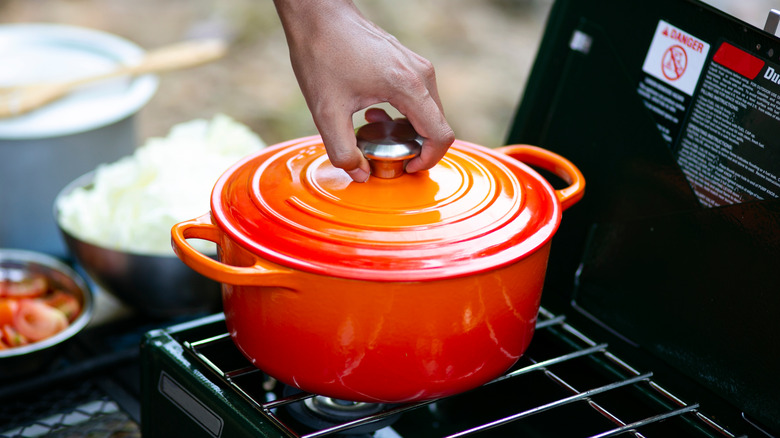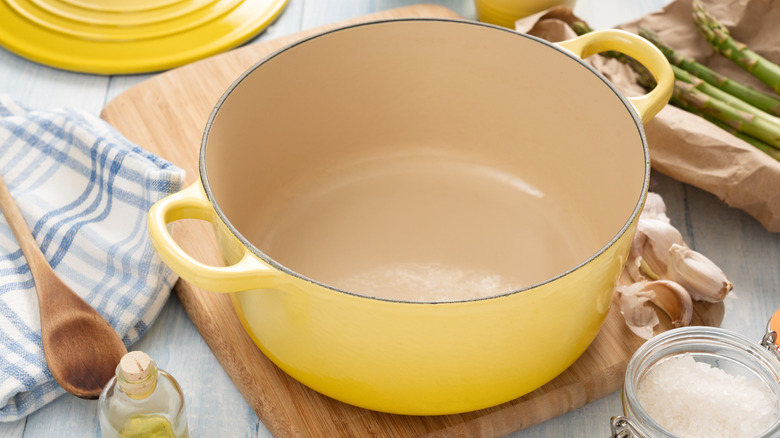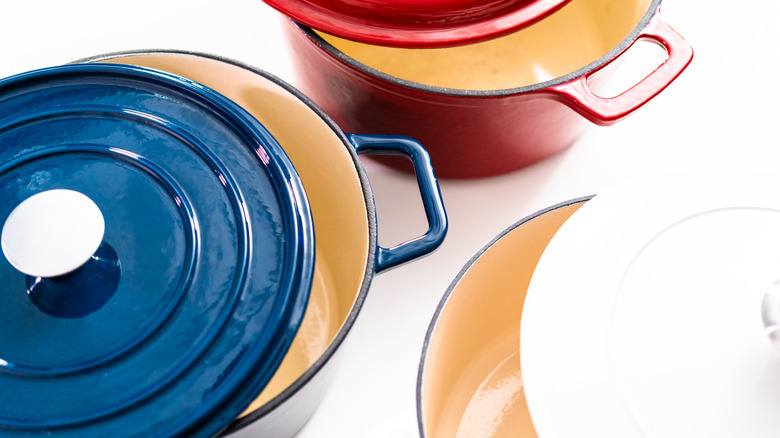Keep Your Dutch Oven Looking Good As New With A Common Kitchen Cleaner
We may receive a commission on purchases made from links.
Dutch ovens are enameled cast iron cookware pieces that are great for cooking stews and soups, deep frying, braising meat, and so much more. Dutch ovens can be expensive and are quite an investment. However, these Dutch ovens can last for decades if you take care of them. So, how do you properly care for a Dutch oven? You can't put them in a dishwasher, and you have to be gentle when cleaning these pans so you don't scratch the surface. Cleaning Dutch ovens with dish soap and a non-abrasive sponge works fine for taking care of the inside of the pan daily. But what about those stubborn, cooked-on stains on the outside of the pan?
It turns out that you can restore the exterior of your Dutch oven to like-new with something that you probably already have in your kitchen — oven cleaner. The good news is that oven cleaner won't scratch the enamel on your cookware. That is because oven cleaner is made to clean enamel on the inside of ovens. So, it's safe to use on Dutch ovens. Here's how to clean your Dutch oven with an oven cleaner.
How to use oven cleaner to make your Dutch oven sparkle
The first step is to take your Dutch oven pan outdoors. Oven cleaners can irritate the lungs, so it's best to do this task in a well-ventilated area like outdoors. Place your Dutch oven on a piece of cardboard. Put a pair of rubber gloves on to protect your hands. Spray the entire surface of your Dutch oven with Heavy Duty Easy Off. Make sure you choose the one with the yellow cap. This version of Easy Off contains lye, which is safe for Dutch ovens.
After you have sprayed your Dutch oven with Easy Off, let it sit with the oven cleaner on it for about 30 minutes. Once the 30 minutes are up, rinse off the Easy Off. Then, thoroughly wash the inside and outside of your Dutch Oven with a mild soap using a gentle non-abrasive sponge. The pot should now look as good as new. Here's a tip — use oven cleaner sparingly on your Dutch oven to avoid damaging the surface. Aim for no more than once every year.
Things to keep in mind
Here are some things that you'll want to keep in mind when cleaning your Dutch oven. First, oven spray should only be used on the outside of the pain — not the inside. Since the inside of your Dutch oven is likely non-stick, it should be easy to clean. However, to remove pesky, burned-on food bits on the inside of your Dutch oven, use baking soda. Pour some into the bottom of the pan, add hot water, and let it soak. Any leftover bits of burned food should come right off. You can then clean the pot with a gentle soap and sponge.
When cleaning both the inside and outside of your Dutch oven, it's important to avoid using harsh cleaning surfaces like steel wool. Make sure you choose a soft sponge or dish rag. Dutch ovens can withstand a lot of abuse. However, at some point, they will need to be replaced. If you have chipped or peeling enamel, it's not recommended to continue using it. Rather than trying to clean a damaged Dutch oven, it's best to get rid of it.


